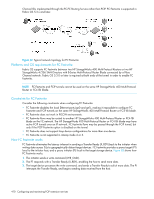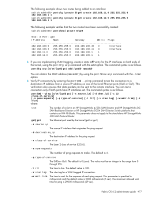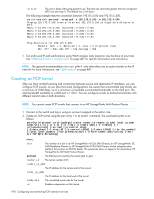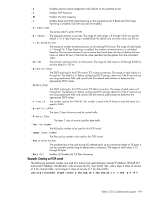HP StorageWorks 8/80 HP StorageWorks Fabric OS 6.2 administrator guide (5697-0 - Page 479
Setting persistently disabled ports, Configuring VEX_Ports
 |
View all HP StorageWorks 8/80 manuals
Add to My Manuals
Save this manual to your list of manuals |
Page 479 highlights
11. If you are implementing FICON emulation, configure FICON emulation using the portCfg ficon command. See Chapter 23, "Configuring and monitoring FICON Extension Services" on page 513 for specific instructions. 12. If you are implementing FTRACE, configure FTRACE using the portCfg ftrace command. See the Fabric OS Troubleshooting and Diagnostics Guide. for specific instructions. 13. Check the configuration to ensure that the parameters are correct using the portShow fciptunnel command. 14. Persistently enable the ports using the portCfgPersistentEnable command. 15. Create the same configuration on the HP StorageWorks 400 Multi-Protocol Router or FC4-18i blade at the other end of the tunnel. Setting persistently disabled ports Ports used on an FCIP tunnel must be persistently disabled before you can configure FCIP tunnels. You must change their state from persistently enabled to persistently disabled. Once the FCIP tunnels have been fully configured on both ends of the tunnel, you can persistently enable the ports. 1. Enter the portCfgShow command to view ports that are persistently disabled. 2. Enter the portCfgPersistentDisable command to disable any ports that you will use in the FCIP tunnel configuration. Configuring VEX_Ports If you are going to use a VEX_Port in your tunnel configuration, use the portCfgVEXPort command to configure the port as a VEX_Port. Remember that a VEX_Port must be paired with a VE_Port. VEX_Ports cannot communicate with other VEX_Ports. 1. Connect to the switch and log in using an account assigned to the admin role. 2. Enter the portCfgVEXPort command to configure a port to a VEX_Port. The command syntax is as follows. portCfgVEXPort [slot/]portnumber [ge0|ge1] [-a 1|2] [-f fabricid] [-r ratov] [-e edtov] [-d domainid] [-p 0|1|2] [-t 1|2] where: slot The number of the slot in an HP StorageWorks 4/256 SAN Director or HP StorageWorks DC SAN Backbone Director or HP StorageWorks DC04 SAN Director Switch enterprise-class platform that contains an FR4-18i blade. This parameter does not apply to the stand-alone HP StorageWorks 400 Multi-Protocol Router. ge0|ge1 The Ethernet port used by the tunnel (ge0 or ge1). -a 1|2 Enables or disables admin (1 to enable or 2 to disable). -f fabricid The fabric ID (a number from 1 to 128). -r ratov The R_A_TOV used for port negotiation. Valid values are 2000 - 120000. This operand is applicable only if the "Fabric Parameter" attribute value is not "Auto Negotiate". -e edtov The E_D_TOV used for port negotiation. Valid values are 1000 - 60000. This operand is applicable only if the "Fabric Parameter" attribute value is not "Auto Negotiate". -d domainid The preferred domain ID (a number from 1 to 239). -p 1|2|3 The port ID format (1 for core, 2 for extended edge, and 3 for native). -t 1|2 Specify 1 to enable or 2 to disable negotiate fabric parameters. The following example configures a port as a VEX_Port for slot number 8 in port number 18, enables admin, and specifies fabric ID 2 and preferred domain ID 220: switch:admin> portcfgvexport 8/18 -a 1 -f 2 -d 220 Fabric OS 6.2 administrator guide 475















